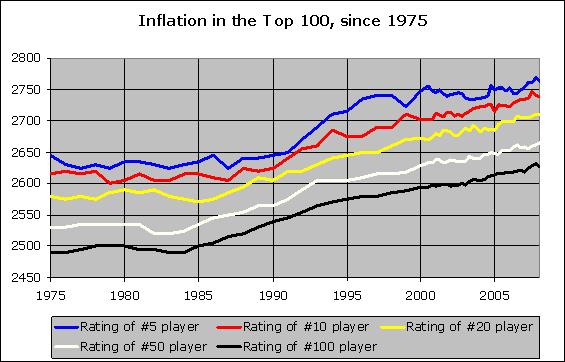Elo oddities: the tortoise and the hare
Chinese GM Li Chao recently rejoined the 2700 club after winning 5.6 Elo from
his 9.0/9 victory at the 5th Colombo International Chess Festival 2012. While
nine in nine sounded impressive, the results
page showed something quite odd: the Chinese player had a 2622 performance,
considerably below his 2693 rating. Six of the eight rated opponents had ratings
under 2000 and one was even rated 1405. In spite of this he had still managed
to gain 5.6 Elo. How was that possible?
The reason is that today games are rated individually, and any player rated
400 Elo or more below your rating will still yield 0.8 Elo. At a time when the
minimum FIDE rating was 2200 the greatest disparity possible was around 600
Elo, but now games with a full 1400 Elo difference could take place.
Could this be the source of ratings inflation? Perhaps Magnus Carlsen could
find a much easier way to break Garry Kasparov’s record: win a few very
weak opens, and presto! He would be the new record holder, even if he did not
play a single opponent within a thousand Elo of his rating.
In order to get to the truth of the matter, experts and mathematicians Jeff
Sonas, John Nunn, and Ken Thompson were consulted and held a dialogue between
themselves which we publish here.
Jeff Sonas, Statistician and creator of Chessmetrics,
was the first to reply.
My understanding is that this rule was introduced for political reasons
long ago, purportedly to give top players some incentive to play in open events.
When FIDE proposed raising the cutoff from 350 points to 400 points a couple
of years ago, and asked for my opinion, I agreed that it was a change in the
right direction, and stated that it would be even better to go up to 500 instead.
I have since changed my opinion on this, and decided we either should get rid
of the rule altogether, or make it an "800-point rule" instead. You
can see my most
recent analysis from a year ago I discuss the 400-point rule amongst the
two graphs that have large blue rectangle outlines, about halfway down.
There is a statistical rationale for the rule to some degree, since the
chaotic nature of chess (and the variability of ratings) means you can never
really be 100% sure that one player will beat another, and rarely can you even
be 99% sure. It is certainly not a "guarantee" to score 100% in a
whole event. For one thing, it is quite possible that opponents paired against
the tournament leader in a late round of a Swiss would have done better than
expected and in fact would be stronger than their pre-tournament rating would
indicate. I think an 8.5/9 score for Li Chao in such an event would be
a reasonable prediction, and would not have resulted in a single point of Elo
gain for him.
But yes, if someone strong were able to organize lots of events like this,
and the rating administrators looked the other way, a strong player would likely
be able to boost their own rating a bit. I certainly don't think it has much
to do with the increased ratings of top players, though, and the artificially
high rating would sort itself out eventually because it would also artificially
increase the player's predicted score and they would therefore struggle to maintain
the artificially high rating. In this way the Elo system is supposedly
“self-correcting”, although I’m not sure this really works
very rapidly when opponents’ ratings are at all inaccurate.
Ken Thompson, computer chess pioneer
I don’t think it makes a difference whether you pick a large number
(say 400 or 800) and employ this rule. I don’t think that human-human
interactions will accurately follow the normal curve beyond this point. Even
if it is true that this difference can be milked for rating, there are several
practical issues working against it. The player has to spend lots of silly time
pounding on weak players to gain points. He has to continually keep vigilance
to accomplish this. One mistake and he will lose many times what he has slowly
gained. Once the player has amassed his 3800 Elo, what is he to do with it?
Compete and give it to strong players? Sit on it and brag about being on the
top of the rating lists? I don’t think this is a cause of inflation
since the weaker player loses as many points as the stronger player gains, i.e.
zero sum, no inflation.
John Nunn, Grandmaster, mathematician
This rule was introduced for a simple reason: to prevent players losing
Elo points by winning a game. If one player in a tournament is rated
far below the others, then including that player can lower the average rating
of your opponents by so much that your expected score is increased by more than
one point. Then beating that player will leave you worse off than if you had
not played him at all. This is not just an academic situation. For
very strong players it could easily happen in cases where, for example, a strong
tournament includes a 'local player' who is much weaker than the others, or
in Olympiads where your first round opponent was relatively weak.
In recent years there have been a few cases in which relatively well-known
GMs have apparently attempted to exploit this rule by playing in very weak tournaments.
However, in these cases the player concerned only appears to have gained a few
points (less than five). Of course, by doing the same thing over and over again
a player could artificially boost his rating, but it would be very time-consuming.
Jeff Sonas (to John Nunn)
It seems to me that the scenario you describe (wanting to avoid a victory
over a low-rated player causing you to lose rating points) motivated the rule
to calculate rating change on a game-by-game basis instead of using average
opponent rating for an event. It also motivates the related tiebreak rule that
might calculate performance rating after first removing the lowest-rated opponent,
where we don't want to penalize someone's performance rating due to a win against
a very weak player.
However, I don't see how capping the expected score at 89% would prevent
players losing Elo points due to a win. As long as you are calculating
rating change on a game-by-game basis, even with an expected score of 99% or
100% you would still never lose rating points from a win.
John Nunn (to Jeff Sonas)
The original rating rules had no 350-point rule. It must be remembered
that in 1970 the rating list was very small and it was never envisaged that
it would be extended substantially. Only top tournaments were rated (and these
were invariably all-play-all events) and all calculations were done by hand.
The 'Losing Rating Points For Winning A Game' problem didn't really arise. The
top players always skipped the first round or two of an Olympiad, and in any
case any weak opponents would be unrated, so the games simply didn't count.
But times changed, the rating list expanded and started including more
and more weaker players. Open tournaments appeared, and the LRPFWAG problem
started to become significant. I don't remember exactly when the 350-point rule
was introduced to deal with this, but I believe it was around 1980. Later,
in 1988 or 1989, Karpov was unhappy about losing points when he had won a tournament,
arguing that the aim of taking part in a tournament was to win it, and if you
have achieved that then you shouldn't lose points through not having won by
a large margin. For a time the 'Karpov rule' was in effect, that you couldn't
lose points for winning an event. This was later scrapped.
Rating games individually is a fairly recent innovation, and for the vast
bulk of the lifetime of the Elo system it was done on a tournament basis (because
it made the calculations easier, especially for all-play-all events). The
current rule is in a way a hangover from the earlier times, but I think there
is some logic in it, although one can argue over the exact details. Rapidly
improving young players, for example, can be massively underrated.
What to make of all of this? To start with, one must reiterate Ken Thompson’s
point that it is ultimately a zero-sum game. In other words, even if a 2700
player can win Elo by beating rank beginners, those beginners will also lose
the same corresponding Elo. So, does this mean all is okay? Sort of.
As explained by Jeff Sonas if the purpose is to prevent a player from losing
Elo because he won a game, then rating each game individually solves this even
without a ratings cap. The artificial 400 Elo cap just means that the FIDE rating
system will always consider that any player rated at least 1400 never has worse
than an 8% chance against another player whether he be Magnus Carlsen, Garry
Kasparov, or Bobby Fischer. We beg to disagree.
Still, does that mean there is no inflation? Perhaps, perhaps not. Jeff
Sonas explained:
In my opinion the main source of inflation is that newly rated players
are receiving ratings that on average are too high, which is basically injecting
rating points into the pool. This is possibly because rated players take it
easy on unrated players in their games, and the unrated players therefore are
showing an artificially high performance rating in those games. I have demonstrated
through simulation that over a few years, these excess rating points (despite
appearing only in new players) will gradually propagate through the entire rating
pool, eventually reaching the very top. I believe this to be one possible
explanation for the effect seen in the following graph:

(taken from Rating
inflation – its causes and possible cures)
If excess rating points were appearing at the bottom of the pool, and slowly
distributing around, you would eventually see the rating of the #100 player
(whoever that may be) go up, then the #50 player, and finally (maybe even years
later) the #10 or #5 player. As I said, I have demonstrated in FIDE meetings
that a more aggressive (or more conservative) formula for new player ratings
will ultimately raise (or lower) everyone’s rating, depending on players’
connectivity within the rating pool. So a zero-sum operation will eventually
settle down to become non-inflationary, I believe. Within reason.
I certainly don’t think the “350 point rule” or “400
point rule” explains all of the 2800+ ratings and 2700+ ratings we are
seeing; I think it is far more likely that it comes from new players’
initial ratings.
Copyright
ChessBase
























